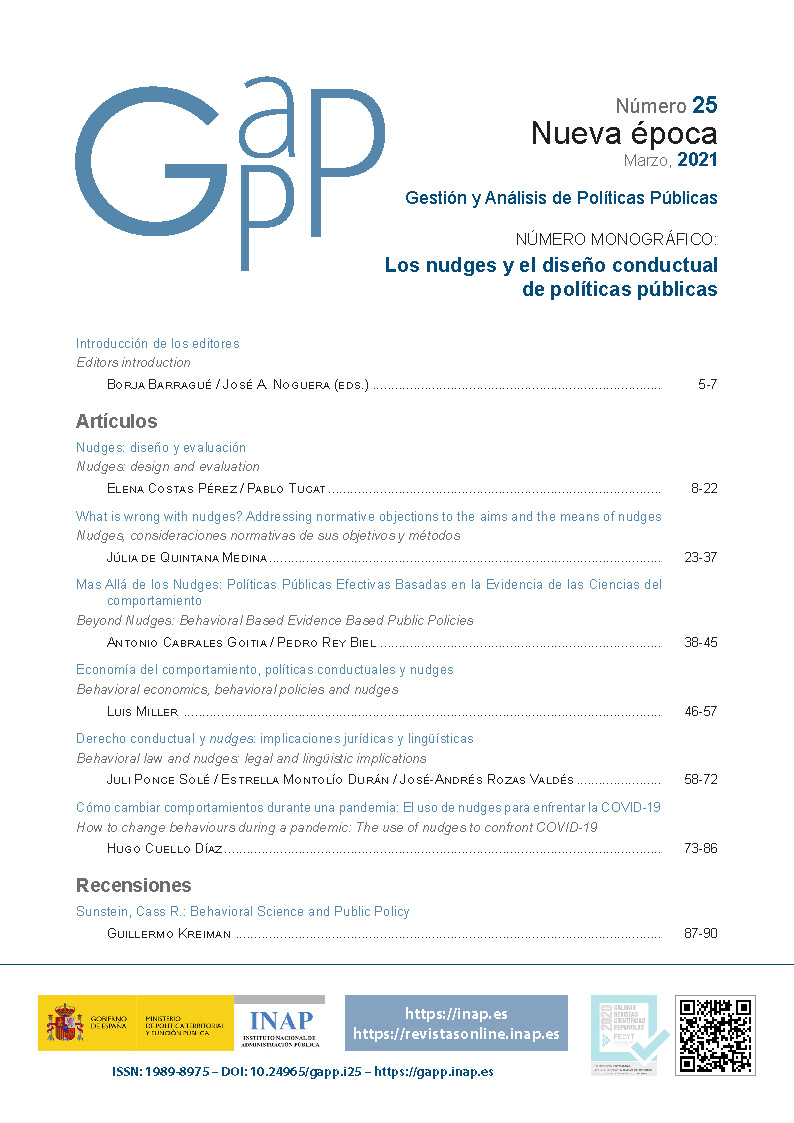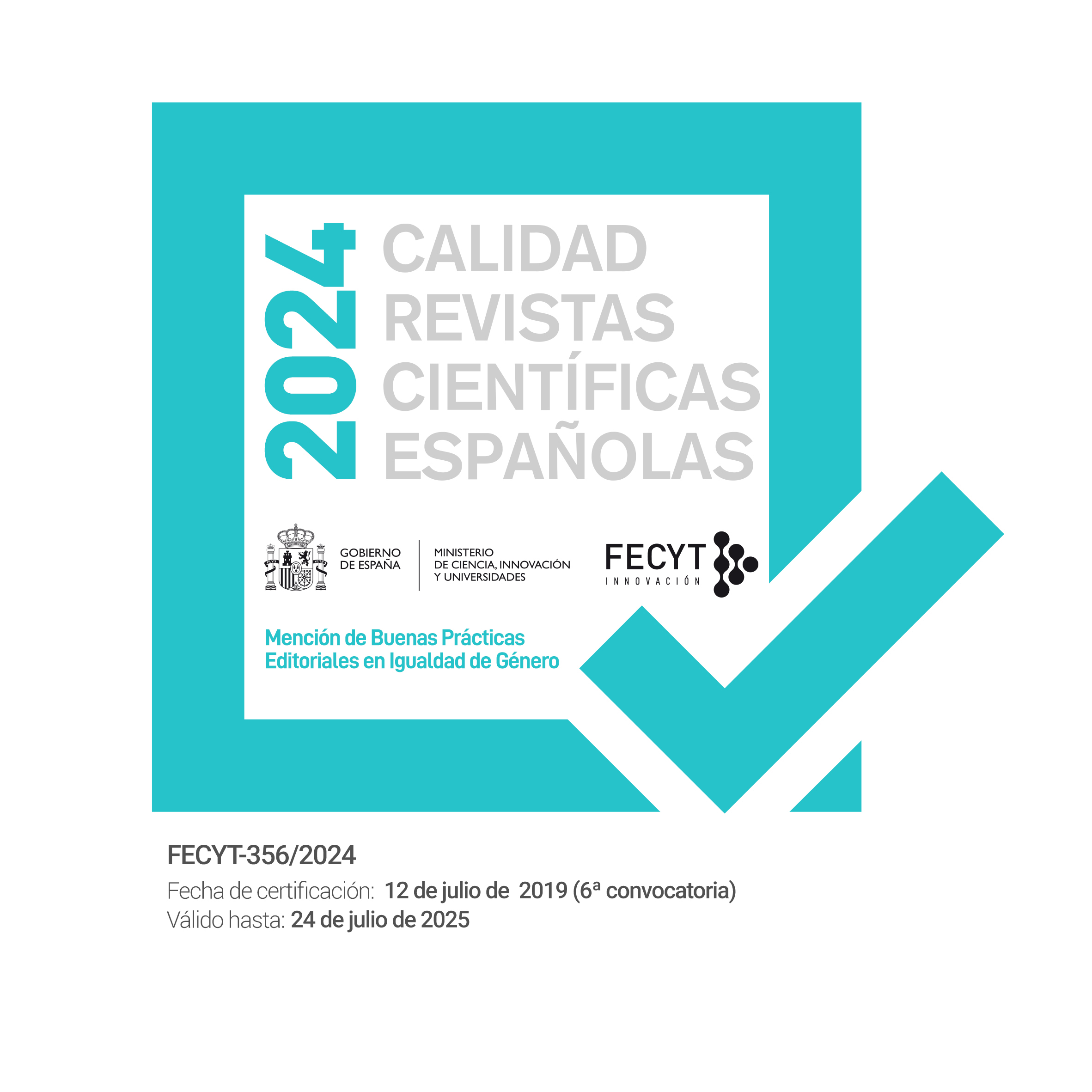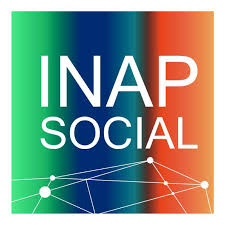Economía del comportamiento, políticas conductuales y nudges
DOI:
https://doi.org/10.24965/gapp.i25.10866Palabras clave:
Políticas conductuales, incentivos, decisiones individuales, preferencias sociales, coordinaciónResumen
Las políticas conductuales, en general, y los nudges, en particular, forman parte de la caja de herramientas que nos permite mejorar el diseño y la aplicación de políticas basadas en la evidencia. Las propuestas de las nuevas ciencias del comportamiento son un complemento de las más tradicionales basadas en incentivos. En este artículo discuto tres ámbitos de aplicación de las políticas conductuales, así como su relación con intervenciones más clásicas, en situaciones que incorporan un nivel de complejidad creciente. Primero, me detendré en situaciones donde nos enfrentamos a problemas de decisión individual. Segundo, en situaciones que tienen en cuenta a otras personas. Por último, abordaré situaciones donde existe interacción social entre personas.
Descargas
Citas
Ariely, D. y Zakay, D. (2001). A timely account of the role of duration in decision making. Acta Psychologica, 108(2), 187-207. https://doi.org/10.1016/s0001-6918(01)00034-8
Arkes, H. y Blumer, C. (1985). The psychology of sunk cost. Organizational Behavior and Human Decision Processes, 35(1), 124-140. https://doi.org/10.1016/0749-5978(85)90049-4
Bateson, M., Nettle, D. y Roberts, G. (2006). Cues of being watched enhance cooperation in a real-world setting. Biology letters, 2(3), 412-414. https://doi.org/10.1098/rsbl.2006.0509
Brandstätter, H. y Güth, W. (1994). Essays on economic psychology. Springer.
Camerer, C. (2000). Prospect theory in the wild: evidence from the field. En Choices, values and frames, Editado por Daniel Kahneman y Amos Tversky. Cambridge university press.
Centola, D. y Macy, M. (2007). Complex contagions and the weakness of long ties. American Journal of Sociology, 113(3), 702-734. https://doi.org/10.1086/521848
Charness, G. y Gneezy, U. (2009). Incentives to exercise. Econometrica, 77(3), 909-931. https://www.jstor.org/stable/40263846
Epstein, L. (1999). A definition of uncertainty aversion. The Review of Economic Studies, 66(3), 579-608. https://doi.org/10.1111/1467-937X.00099
Forberger, S., Reisch, L., Kampfmann, T. y Zeeb, H. (2019). Nudging to move: a scoping review of the use of choice architecture interventions to promote physical activity in the general population. International Journal of Behavioral Nutrition and Physical activity, 16, artículo 77. https://ijbnpa.biomedcentral.com/articles/10.1186/s12966-019-0844-z
Frederick, S., Loewenstein, G. y O’Donoghue, T. (2002). Time discounting and time preference: a critical review. Journal of Economic Literature, 40(2), 351-401. https://doi.org/10.1257/002205102320161311
Galla, B. y Duckworth, A. (2015). More than resisting temptation: beneficial habits mediate the relationship between self-control and positive life outcomes. Journal of Personality and Social Psychology, 109(3), 508-525. https://doi.org/10.1037/pspp0000026
Green, D. y Gerber, A. (2015). Get out the vote: how to increase voter turnout. Brookings Institution Press. https://www.jstor.org/stable/10.7864/j.ctt1657t5x
Gilovich, T., Griffin, D. y Kahneman, D. (2002). Heuristics and biases: the psychology of intuitive judgment. Cambridge University Press.
Gintis, H. (2009). The bounds of reason. game theory and the unification of behavioral sciences. Princeton University Press.
Gigerenzer, G. y Selten, R. (2002). Bounded rationality: the adaptive toolbox. MIT Press.
Gneezy, U., Meier, S. y Rey-Biel, P. (2011). When and why incentives (don’t) work to modify behavior. Journal of Economic Perspectives, 25(4), 191-210. https://doi.org/10.1257/jep.25.4.191
Granovetter, M. (1978). Threshold models of collective behavior. American Journal of Sociology, 83(6), 1.420-1.443. http://www.jstor.org/stable/2778111
Hertwig, R., Pachur, T. y Kurzenhäuser, S. (2005). Judgments of Risk Frequencies: Tests of Possible Cognitive Mechanisms. Journal of Experimental Psychology: Learning, Memory, and Cognition, 31(4), 621-642. https://doi.org/10.1037/0278-7393.31.4.621
Hossain, T. y List, J. (2012). The behavioralist visits the factory: increasing productivity using simple framing manipulations. Management Science, 58(12), 2.151-2.167. https://doi.org/10.1287/mnsc.1120.1544
James, M. (2017). Handbook of behavioral economics and smart decision-making: rational decision-making within the bounds of reason. Edward Elgar Publishing.
Johnson, E. y Golstein, D. (2003). Do defaults save lives? Science, 302(5.649), 1.338-1.339. https://doi.org/10.1126/science.1091721
Kahneman, D., Knetsch, J. y Thaler, R. (1991). Anomalies: The Endowment Effect, Loss Aversion, and Status Quo Bias. Journal of Economic Perspectives, 5(1), 193-206. https://doi.org/10.1257/jep.5.1.193
Kahneman, D. (2012). Pensar rápido, pensar despacio. Debate.
Kelling, C. y Coles, G. (1998). Fixing broken windows: restoring order and reducing crime in our communities. Simon & Schuster.
Knight, F. (1921). Risk, uncertainty and profit. Houghton Mifflin Harcourt.
Kucharski, A. (2020). Las reglas del contagio. Capitán Swing.
Laibson, D. (1997). Golden eggs and hyperbolic discounting. Quarterly Journal of Economics, 112(2), 443-477. https://doi.org/10.1162/003355397555253
Miller, L. (2007). Coordinación y acción colectiva. Revista Internacional de Sociología, 65(46), 161-183. https://doi.org/10.3989/ris.2007.i46.8
O’Donoghue, T. y Rabin, M. (2015). Present bias: lessons learned and to be learned. American Economic Review, 105(5), 273-279. https://doi.org/10.1257/aer.p20151085
Schelling, T. (1960). The strategy of conflict. Harvard University Press.
Simon, H. (1955). A behavioral model of rational choice. The Quarterly Journal of Economics, 69(1), 99-118. https://doi.org/10.2307/1884852
Stigler, G. y Becker, G. (1977). De Gustibus Non Est Disputandum. The American Economic Review, 67(2), 76-90. https://www.jstor.org/stable/1807222
Thaler, R. y Sustein, C. (2008). Nudge: improving decisions about health, wealth, and happiness. Yale University Press.
Tversky, A. y Kahneman, D. (1981). The framing of decisions and the psychology of choice. Science, 211(4.481), 453-458. https://doi.org/10.1126/science.7455683
Tversky, A. y Kahneman, D. (1974). Judgment under uncertainty: heuristics and biases. Science, 185(4.157), 1.124-1.131. https://doi.org/10.1126/science.185.4157.1124
Descargas
Publicado
Cómo citar
Número
Sección
Licencia
Derechos de autor 2021 Gestión y Análisis de Políticas Públicas

Esta obra está bajo una licencia internacional Creative Commons Atribución-NoComercial 4.0.












